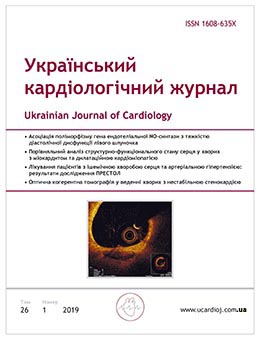Features of laboratory-diagnostic indicators in patients of different age groups with ST-elevation acute coronary syndrome
Main Article Content
Abstract
The aim – to find out the features of laboratory diagnostic indicators in patients of different age groups with
ST-elevation acute coronary syndrome.
Materials and methods. Were analyzed the data of 835 patients admitted to the emergency departments from January 2000 to December 2015, with ST-elevation acute coronary syndrome. Patients were divided into the two groups depending on age: I group – patients < 45 years of age (n=189), II group ≥ 45 years (n=646).
Results and discussion. In young patients, hemoglobin and platelet levels were significantly higher throughout the observation period. Initial ALT and AST were significantly higher in young patients on day 1 (p<0.001 and p<0.01, respectively), but didn’t differ further. Baseline glucose level in patients < 45 years of age was significantly lower than in the older group (p<0.05). Patients < 45 years had higher values of fibrinogen (p=0.048). Young adults had lower total cholesterol, LDL at baseline (p<0.05) and the day 7 (p<0.001). Patients of 1 group showed higher HDL-C and TG (p<0.05). Probable FH was more common in the patients <45 years (7.34 and 1.32 %, p<0.05), in spite of lower HDL (3.47±0.12 and 3.83±0.08 mmol/l, p<0.05).
Conclusions. The most significant risk factors for a MI at a young age are dyslipidemia and increased TG even in the absence of hypercholesterolemia. When allocating the group of familial hypercholesterolemia in patients with myocardial infarction at a yo≤ung age, familial hypercholesterolemia is observed significantly more often. The development of MI at a young age is often accompanied by an increase in the level of fibrinogen, hemoglobin and platelets, which may have a prothrombogenic effect.

